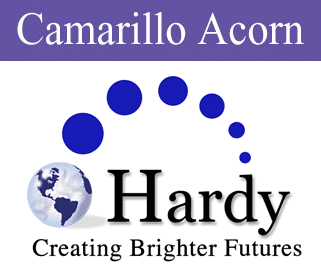Featured in the News: Finding focus, one clap at a time

Kids use simple program to improve concentration
By Michael Blank
Special to the Acorn
It’s a weekday afternoon at the Camarillo Boys & Girls Club and about a dozen children ages 5 to 8 enter the computer room. Each puts on headphones, straps a round plastic button to one hand and starts clapping.
Most of these children are struggling in school, and some have learning disabilities such as Attention Deficit Hyperactivity disorder.
They are participating in a three- to four-week pilot program called Hardy Brain Camp, a unique form of therapy designed to help the young pupils focus and succeed in school.
The computer plays a metronome beat in the headphones, and the children try to clap with the sound. The computer records how many times they succeed, get close, or miss the beat. As they improve their accuracy, the sessions become harder.
“It’s using milliseconds to train your brain to speed up its reflexes,” said Erica Binns, a youth development professional at the Camarillo Boys & Girls Club. “It improves their focus, their attention span, helps them improve in school.”
The technology is called interactive metronome and helps improve the brain’s response time and its ability to focus.
“That’s the same kind of timing put into place when you first try to ride a bike,” said Sherrie Hardy, the Camarillo-based education therapist who created Hardy Brain Camp. “Remember when you first tried to ride it, you were wobbly, and you didn’t have the knack of it. But once you have learned how to ride, you can get on a bike now even if you haven’t been on one in 20 years and ride it successfully because you’ve got a timing pattern in your brain.”
Hardy discovered interactive metronome technology a decade ago while searching for a solution to her own daughters’ attention problems. In 2003, Hardy founded her own therapy business, offering clients a customized version of the interactive metronome.
She also founded a nonprofit, the Hardy Brain Training Foundation, to bring the technology to children whose parents could not afford the $2,700 cost of private therapy sessions.
About three years ago, Jeffrey Henley, chairman of the technology giant Oracle Corp. and member of the board of governors for the Boys & Girls Clubs of America, suggested to Hardy she introduce her program to the youngsters at the clubs.
Henley’s nonprofit foundation, J & J Family Foundation, and Hardy’s nonprofit partnered to try the program on three children at the youth club in Oxnard. The three students scored higher on standardized tests after finishing the program, which led Hardy and Henley to fund additional pilot programs at other clubs, including Camarillo.
These clubs offer Hardy Brain Camp for no cost or for a small charge of $5.
Hardy said they are planning to expand Hardy Brain Camp to clubs nationwide.
“It’s just been an amazing project for us. We’ve helped so many kids who wouldn’t get this kind of help in any other way,” she said.
Two studies, one from California Lutheran University and the other from UC Santa Barbara, support that the program’s methodology is effective.
The CLU study tested 54 children struggling in school and found that after going through Hardy Brain Camp they scored higher on standardized tests in the areas of reading, math and processing speed.
Hardy says that the gains from the program are permanent, and a yearlong study of Rio School District students showed continued advances in math and reading.
Longer-term studies have not yet been done.
Erica Binns says she noticed a definite change in the children she oversees at the Camarillo club. She gives each child a math and literacy test before and after the program. The children have three minutes to separate words from a block of text, and three minutes to complete math problems.
” We do pre- tests, we do post-tests, and I definitely saw an improvement in their attention span,” Binns said. “Now it wasn’t necessarily how many they got right, but how many they at least attempted and tried to complete. A lot of them when they first took the pre-test were looking all over the place, talking, chatting with each other, you know: completely in La La Land.”
Roberto Martinez, vice president of programs at the club, also noticed an improvement in the children participating.
” In the homework room they’re less distracted, and we’re seeing the same results at school.”
He also said that the children are more attentive to their peers and authority figures.
The children seem to enjoy Hardy Brain Camp.
“They definitely like it. They like shouting out their scores, and how many in a row they have gotten,” Binns said. “They get prizes after each session and that definitely makes them want to do it even more.”
Mercedes Ochoa, 7, who attends the “Brain Beat” session for younger children, rated Hardy Brain a “half thumbs-up” because she did not like standing the entire half-hour.
Still, on the whole, she said she liked the program “because you get to be on free play with all sorts of games,” referring to the software’s option to play metronome games after a day’s assignment.
The Camarillo Boys & Girls Club offers two Hardy Brain Camp sessions: a three-week program of 30 minute sessions for children ages 5 to 8 called “Brain Beat”; and a four-week program of 50 minute sessions for children ages 7 to 18.
For more information visit www.bgccam.org.
To read article at theCamarilloAcorn.com click here.
